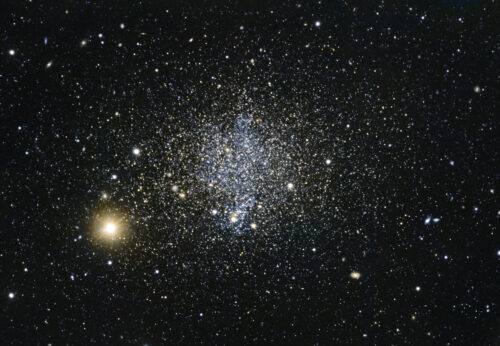Image courtesy of ESA/Hubble & NASA.
Star formation is so innate to the existence of galaxies that the loss of a galaxy’s precious, star-forming gas is a sentence to a tragic end. This end is the reality for some dwarf galaxies—small systems that carry a few billion stars, in contrast to the upwards of one hundred billion stars in our Milky Way. These dwarf galaxies are prone to losing their star formation ability in a process known as quenching.
Quenching was believed to require local environmental processes, such as entrapment in the hot halo of a galactic cluster which results in the loss of cold gas. Consequently, dwarf galaxies isolated from other galactic bodies would theoretically be safe from quenching.
However, a new study from Yale astrophysicists led by graduate student Imad Pasha offers insightful additions on the cosmological mechanisms responsible for quenched dwarf galaxies
The cosmic web is a network of filamentary and sheet-like structures of dark matter, gas, and galaxies, with nodes at connecting points typically containing galaxy groups and clusters. Cosmic sheets within the web are in constant collision with each other. Their impacts send out accretion shocks that can quickly heat the gas surrounding a galaxy, stripping away the cold gas required to form stars and cutting off a galaxy’s fuel supply. Using simulations, Pasha discovered that accretion shocks from cosmic sheets can lead to large-scale environmental quenching, even in isolated dwarf galaxies.
“The most surprising result, if anything, was the uniformity with which dwarf [galaxies] below a certain mass tanked their star formation rates and quenched after interacting with the sheet,” Pasha said.
However, observational samples of dwarf galaxy populations are small because these systems are faint. Thus, current methods of counting galaxies may accidentally exclude dwarf galaxies quenched by cosmic sheets. “The collapse of large-scale structure and sheet collisions are universal processes, but aren’t really being included in the way people think about how galaxies got to where they are,” Pasha said
This research was made possible by the contributions of Pasha’s team, from graduate students to postdocs, and faculty. “A lot of progress can be made, and a lot of great mentorship and scientific exchange can occur when you step back from the science and examine the human aspects of how science is done,” Pasha said.
There is no shortage of direction for future research on dwarf galaxies. Over the last billion years, dwarf galaxies in the local volume around the Milky Way have seen their star formation go up and down in tandem with each other, even without a causal connection. This phenomenon is not well understood, but new technologies such as the Large Synoptic Survey Telescope at the Vera C. Rubin Observatory in Chile may bring about better observations to aid our understanding of the tragic fate of quenched dwarf galaxies.

